Hitler’s Bank Earns its Name
Note: Presented in this installment is Part IV of “The Unknown Story of the Bank for International Settlements,” entitled “Hitler’s Bank Earns Its Name.” As noted in past installments, to get the most out of this series it should be read in sequence, starting with the Introduction and then continuing with Parts I, II, and III before tackling Part IV. To make this easy to do I have provided links to the earlier installments here:
In those earlier installments we have covered the history of the founding of the BIS, who founded it, and why. Because the establishment of the BIS took place during the same time and out of the same circumstances as the rise of Nazi Germany, in Part III we have covered much about how Hitler was able to come to power, which is essential context to understanding the role the BIS would play as Germany was re-built across the mid 1930s and launched into its aggression in the late 1930s, thus resulting in World War II. Also, as with earlier installments, I am including a link to Adam Lebor’s excellent book, cited often in this series, “Tower of Basel: The Shadowy History of the Secret Bank that Runs the World” at the close of this article, should you want to procure your own copy. Now, with all that understood, here is Part IV of “The Unknown Story of the Bank for International Settlements”—“Hitler’s Bank Earns Its Name.” I hope you enjoy it and learn from it…MA
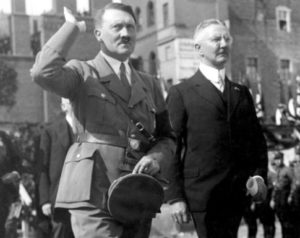
In his biography of Montagu Norman, author John Hargrave [1] makes the following statement: “It is quite certain that Norman did all he could to assist Hitlerism to gain and maintain political power, operating on the financial plane from his stronghold in Threadneedle Street.” (“Threadneedle Street” is the street in London on which the Bank of England is located) As evidence of his claim Hargrave goes on to describe a meeting that took place at the British central bank’s compound in early1934. Present at the meeting with Montagu Norman were Sir Robert Kindersley, Sir Josiah Stamp, Charles Hambro and Frank Tiarks, all of whom were directors of the Bank of England at the time. At the meeting, according to Hargrave, Norman spoke of, “…the political situation in Europe. A new power had established itself, a great ‘stabilizing force’, namely, Nazi Germany. Norman advised his co-workers to include Hitler in their plans for financing Europe. There was no opposition.”
Of course we know from the earlier installments in this series of the tight bond and friendship connecting Montagu Norman and Reichsbank president Hjalmar Schacht as co-founders of the BIS; and of the relationship between Nazi banker Kurt von Schröder and Frank Tiarks, who in addition to being a Bank of England director, was also a partner of London based J.H. Schroders and Co. With this support, and with his country at last free from the vestiges of reparations and Dawes/Young plan repayments, in 1934 Schacht got down to the business of rebuilding the German economy. As described by Adam Lebor in “The Tower of Basel,” by 1939 he had succeeded mightily: “Schacht had wrought a miracle,” Lebow says, “—a centrally planned economy that was not ravaged by inflation, a worthless national currency or unemployment. In the six years since Hitler had taken power, unemployment had been reduced from 6 million to around three hundred thousand. Armies of the jobless were diverted to massive programs of public work—building the new network of motorways, gigantic public buildings, and planting forests. Arms production was soaring. Trade unions no longer existed and were replaced by the state-run German Labor Front (DAF). The work-shy, along with Jews, leftists and others viewed as undesirables were dispatched to concentration camps.”
What Schacht was really doing, however, and his real mandate from Hitler, was the re-building of the German war machine; quite a trick when one factors in that doing so had been expressly forbidden by the Versailles Treaty ending World War I. In a letter to Hitler in May of 1935 Schacht affirmed this when he stated: “The following comments are based on the assumption that the accomplishment of the armament program in regard to speed and extent, is the task of German policy, and that therefore everything else must be subordinated to this aim, although the reaching of this main goal must not be imperiled by neglecting other questions.”
A few weeks later Hitler reinforced this mission when he gave his Reichsbank president the additional title of “General Plenipotentiary for the War Economy.” According to Adam Lebor, to accomplish the German rearmament goal Schacht, who by any measure was a brilliant man, became little more than, “…a state-sanctioned crook, licensed by Hitler to tear up contracts, steal, extort, and fiddle the Reichsbank’s books.” Using his Reichsbank post and authority Schacht mis-allocated (stole) the funds of foreign depositors at the Reichsbank and requisitioned (stole) the foreign currency holdings of German citizens. He ruled that all foreign currencies received as payments for exports must be sold to the Reichsbank; and he manipulated the money markets so that foreign companies could not compete equally with German firms.
Most of these ruses pale when compared to what has got to be Schacht’s pièce de résistance of financial chicanery, however; which was the creation of what was known as the “MEFO” bill. The MEFO bill was an instrument that allowed the Nazi government to illegally borrow billions of reichsmarks from the Reichsbank. To understand why Schacht created the MEFO bill you must first realize that in the wake of World War I the German government was only authorized by the terms of its treaty agreements to borrow up to 100 million reichsmarks at a time from the Reichsbank. Under such restriction a rearmament program would be impossible, so the problem had to be solved; and it had to be solved in a way that would be hard to trace. To do this Schacht created a dummy, limited liability company called Metallurgische Forschungsgesellschaft (“Metallurgical Research Corporation” in English; the acronym MEFO is contracted from this name), which company existed only as a balance sheet entity and nothing else. He then had this company issue the MEFO bills to German armaments contractors, ostensibly as payment of sums due. The contractors accepted the bills because they could redeem them for cash at any of a number of German banks, which in their turn knew they could redeem the bills at the Reichsbank. Schacht had thus created an artificial system of funding the German armaments program from the Reichsbank, seemingly without violating the 100 million reichsmark lending stipulation, which, of course, was a lie. By 1939, with the German rearmament program nearly complete and World War II about to start, there were some 12 billion reichsmarks worth of these MEFO bills floating around in Germany.
Meanwhile, as Schacht was rebuilding the German military with his financial sleight of hand gimmicks and crimes, the Nazis were ramping up their undesirable person persecution programs, targeting specifically the Jews. Some of the measures enacted by the Nazis against the Jews from 1933 forward included banning them from owning land and from being newspaper editors; prohibiting them from getting health insurance; prohibiting them from serving in the military, teaching, being an accountant or a dentist; and prohibiting them from becoming doctors and practicing medicine. In September of 1935 the Nuremburg Race Laws were passed which denied to Jews the status of “citizen” and instead categorized them as “subjects” of the Third Reich. The Nuremburg Laws also made it illegal for Jews to marry or have sexual relations with Aryans. The ultimate result of these laws and measures had the practical effect of making it illegal in Germany to be a Jew.
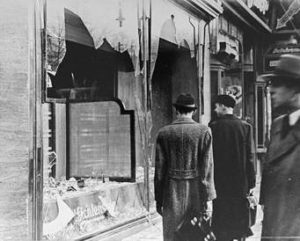
All of this hate mongering against the Jews culminated in what is known to history as “Kristallnacht” (“The Night of Broken Glass”). On the night of November 9th, 1938, in supposed response for the shooting of a German diplomat in Paris a few days earlier by a Jewish teenager whose parents had been mistreated by the Nazis, members of the SS, Hitler Youth and Nazi storm troopers carried out a massive and coordinated attack targeting Jews, their homes, their synagogues and their businesses throughout Germany. According to documents I located in research, “All over Germany, Austria and other Nazi controlled areas, Jewish shops and department stores had their windows smashed and contents destroyed. Synagogues were especially targeted for vandalism, including desecration of sacred Torah scrolls. Hundreds of synagogues were systematically burned while local fire departments stood by or simply prevented the fire from spreading to surrounding buildings / About 25,000 Jewish men were rounded up and later sent to concentration camps where they were often brutalized by SS guards and in some cases randomly chosen to be beaten to death.”[2]
During that night and the following day it is estimated that 7500 mostly Jewish businesses were destroyed and over 250 synagogues were burned while 91 Jews were murdered outright. In the aftermath of the destruction the Nazis added to the outrage by deciding to, “…eliminate Jews entirely from economic life in the Reich by transferring all Jewish property and enterprises to ‘Aryans,’ with minor compensation given to the Jews in the form of bonds.” They then decreed that the German Jews were to be billed the sum of one billion reichsmarks for the destruction caused and that any money arising from Jewish insurance claims on the damage inflicted would be confiscated by the state.
If anyone in the world harbored any illusions about what the Nazis intended for the Jews in Germany and other Nazi controlled areas, Kristallnacht should have shattered them. Indeed, in the wake of the attacks came a storm of negative publicity from newspapers and radio broadcasts around the world about the Nazi atrocities against the Jews; and the United States a short while later was prompted to permanently recall its ambassador from Germany. For the Bank for International Settlements, however, it was simply business as usual. Even though the persecution of the Jews and other minorities was taking place right outside their front door, so to speak, (Basel is located in the northwest section of Switzerland and right on the southwestern border of Germany) the bankers at their Basel banker’s club kept to their code and didn’t concern themselves with the internal affairs of the member nations, including Germany. All that mattered was the smooth flow of international finance, and not the politics of the nations involved. Indeed, Hjalmar Schacht held celebrity status among the central bankers, possibly exceeded only by Montagu Norman himself; a fact noted by none other than Hitler: “Before each meeting of the International Bank at Basel, half the world was anxious to know whether Schacht would attend or not,” he commented in a letter at the time, “and it was only after receipt of the assurance that he would be there that the Jew bankers of the entire world packed their bags and prepared to attend.” [3]
The truth of the matter is that Nazi Germany benefitted greatly just by being a member nation of the BIS. By 1939 the BIS had a total investment in Germany of nearly $100 million. In addition, as reported by Adam Lebor in “Tower of Basel,” the BIS gave Nazi Germany the opportunity to create normal business relations with other nations, and provided the Reichsbank with a volume of communication lines to other central banks. It gave both Schacht and Kurt von Schröder, as Germany’s BIS representatives, marvelous opportunities to gain financial and political intelligence on other member nations; and, by accepting the German Reichsbank on an equal footing with other central banks, it legitimized a bank and a nation that were engaged in a state sponsored terror campaign against, as well as rip off of, the German Jews. Schacht’s stature in the BIS served to make the criminal actions he and the Reichsbank were carrying out somehow acceptable, as if they were just normal business. All of these things combined to make it seem that what was being done by the Nazis in Germany wasn’t really so bad after all, and certainly weren’t the concern of the “cozy Basel banker’s club.”
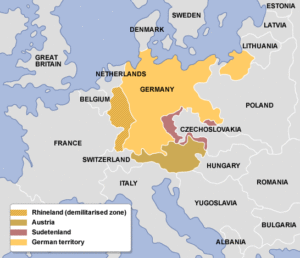
On March 7, 1936, Hitler felt secure enough to order German troops to re-occupy the Rhineland, a strip of German real estate on the nation’s western border along the Rhine River. As a result of the Treaty of Versailles ending World War I the Rhineland was to be a de-militarized zone, and up until 1930 had been occupied by troops from the World War I allied nations that had opposed Germany in that war, chiefly France and England. Taking the Rhineland back was a huge gamble by the Nazi leader, who later privately acknowledged that, “The forty-eight hours after the march into the Rhineland were the most nerve-racking in my life. If the French had marched into the Rhineland, we would have had to withdraw with our tail between our legs, for the military resources at our disposal would have been wholly inadequate for even a moderate resistance.” [4] Neither France nor England, however, did anything in response to Hitler’s bold action.
Hitler’s next major aggressive move came on March 12, 1938, just two years after taking back the Rhineland. Following several weeks of threats, bluster and verbal bullying of Austrian Chancellor Dr. Kurt von Schuschnigg [5] by the Nazi leader, the German Army crossed the border and invaded Austria. Hitler’s troops met no resistance and were often welcomed as heroes by the people they encountered, which included some 7 million ethnic Germans living there. A massive Nazi fifth column [6] activity had been operating in the country for years and they had done their work well. Hitler and the Nazis termed the Austrian invasion Anschluss, which means “Annexation,” and, while France, England and the other nations of Europe stood by and watched, they rapidly went to work consolidating Austria into the Third Reich. They were aided in this process by the Bank for International Settlements, which lifted nary a finger to stop or even protest the Nazi aggression in Austria. On the contrary, the 1938 BIS Annual Report notes that, “In connection with the incorporation of Austria into the German Reich in March and April 1938, the Austrian National Bank entered into liquidation and a series of measures were promulgated transferring most of its assets and liabilities to the Reichsbank.” As Adam Lebow points out in his book, those assets included the Austrian National Bank’s gold reserves and their 4,000 shares in the BIS. The BIS report makes the absorption of Austria, its national bank (which itself had been a BIS member) and its assets by Germany sound like little more than a routine business transaction.
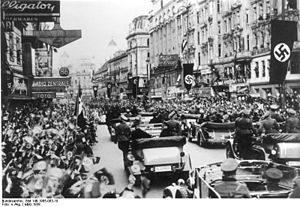
With Hitler’s Austrian takeover concern was growing in European nations and around the world that Germany would, once again, involve them all in war. As a result, on September 29th and 30th, 1938, a summit conference was held in Munich, Germany that was attended by British Prime Minister Neville Chamberlain, along with Hitler, Italian dictator Benito Mussolini and French Prime Minister Edouard Daladier. The conference, and the agreement that emanated from it, signed by those leaders, has become notorious in history as an example of what happens when nations desperate for peace give in to the demands of a belligerent dictator. At issue in the conference was the fate of several sections of Czechoslovakia bordering Germany which, combined, were called the “Sudetenland.” [7] (please see map)
Shortly after the Austrian takeover Hitler and the Nazi’s launched their campaign against Czechoslovakia, first with another well financed fifth column activity within the country to spread upset and disaffection with the Czech government. Then, throughout the summer Hitler and leading Nazi’s, as they had done with Austria, attacked the Czech government in speech after speech decrying that government’s supposed abuse of ethnic Germans in Czech border areas. The September 29-30 Munich conference was actually the culmination of a series of conferences held across that September at which Hitler first asked for, and was given, OK by England and France, and even the Czech government, to annex the Sudetenland. Suddenly, however, simple annexation wasn’t good enough for the Nazi leader. He now demanded that the German army be allowed to occupy the Sudetenland by October 1st and that all non Germans living there be expelled. The Czech government had observed the Austrian example and for the prior 6 months had been beefing up its defenses on the Czech/German border. Allowing the German army to occupy the Sudetenland on such short notice left the Czechs with no time to adapt to the new borders, thus opening up the rest of the country to invasion by the Germans. As a result, for a few days it looked like Europe would erupt in war; but then Hitler suddenly adopted a more conciliatory tone, stating that he was willing to guarantee that Germany would not invade the remainder of Czechoslovakia. Thus, the Munich agreement was signed in the wee hours of September 30th, and Chamberlain returned to England to announce that peace had been secured: “The settlement of the Czechoslovakian problem,” he said, “which has now been achieved is in my view only the prelude to a larger settlement in which all Europe may find peace.”
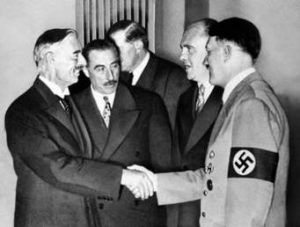
Neville Chamberlain could not have been more wrong. On October 1st, right on schedule, the German Army advanced into Czechoslovakia and took control of the Sudetenland. Three weeks later, on October 21st, Hitler told his generals to start planning for the liquidation of the rest of Czechoslovakia, something that completely violated what he had just agreed to in the Munich pact. Across the first part of 1939 the Nazis stepped up their subversion activities in Czechoslovakia. By early March a Nazi inspired independence movement was gaining traction in the province of Slovakia which resulted, on March 14th, in that province announcing its independence from Czechoslovakia. Seeing his country disintegrating before his eyes, Czech president Dr. Emil Hácha [8]contacted Hitler to set up a meeting with him in person. In the early morning hours of March 15th the two leaders met at the Reich Chancellery in Berlin. At the meeting Hitler employed the same bullying style diplomacy he had used against Austrian chancellor Kurt von Schuschnigg to force Hácha to agree to hand his country over to the Nazis. He yelled and bellowed and threatened the Czech leader with the destruction of Prague, the Czech capital, by the German air force. Feeling he had no choice, Hácha agreed and signed a document stating that he was placing, “…the fate of the Czech people and country in the hands of the Führer of the German Reich.” A couple of hours later, with a late winter snow storm raging, the German army rolled on in to the heartland of Czechoslovakia.
What happened next demonstrates the extent to which the Bank for International Settlements was literally becoming an agent of Nazi Germany. Having observed the fate of its neighboring country Austria, sometime before the Germans absorbed the Sudetenland the Czech government transferred the bulk of its national gold supply, nearly 90 metric tons (over 88,000 kilograms), to two accounts it had established at the Bank of England in London. The first account was in the name of the BIS [9], and the second was in the name of the National Bank of Czechoslovakia. The governor of the Czech bank, a man named Josef Malik,[10] and his associates felt that through their prudent action the Czech gold would be safe, regardless of what the Germans did with their country. When the Germans took over the Sudetenland they also came into possession of a good portion of the Czech banking system, and rapidly undertook the process of replacing the previous Czech currency with the German reichsmark in that territory. Ostensibly to back the reichsmark as a currency there, in February of 1939 Hitler demanded of the Czech government that it transfer to Germany 14.5 metric tons of gold, which the Czechs did not do. A month later, on March 15th, the German army arrived in the Czech capital of Prague and created the German protectorate of Bohemia and Moravia out of what had been the heartland of the Czech nation. For all practical purposes, but for its national gold reserves, the country of Czechoslovakia had ceased to exist.
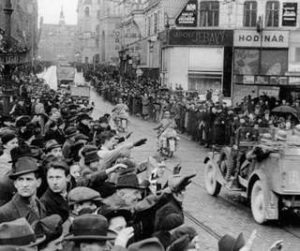
Three days later, on March 18, 1939, a German Reichsbank official arrived at the National Bank of Czechoslovakia in Prague and ordered the directors there, under threat of death, to issue two instructions: the first ordered the BIS to transfer all of the gold held in the Czech BIS account at the Bank of England, some 23 metric tons worth, to the Reichsbank BIS account, also at the Bank of England. The second instruction ordered that nearly 27 metric tons of gold be transferred from the National Bank of Czechoslovakia’s account at the Bank of England to the BIS’s gold account there. Josef Malik and his fellow Czech bankers, knowing that the rest of the world by now knew of Germany’s illegal occupation of Czechoslovakia, an action taken in clear violation of the Munich accords agreed upon just a few months earlier, were hoping that it would be obvious to the BIS and Bank of England officials that the orders must have been issued under duress, and therefore wouldn’t follow them.
But, as Adam Lebor points out in his book, “…Malik had not reckoned on Montagu Norman. The governor of the Bank of England had no interest in whether Czechoslovakia was free or a Nazi colony. ‘Political’ considerations must not affect the BIS’s transactions. The transfer order, he said, must go through.” Likewise, the BIS president at the time, a Dutch banker named Johan Beyen, agreed that as long as the paperwork was in order the gold must be transferred, but was paralyzed by the idea that he would have to be the one to make the final decision. Thus, he wavered, choosing to seek advice from BIS legal counsel and other officials. Finally he was informed that, in addition to the Bank of England, the Bank of France also would be doing nothing to stop the transaction,[11] so Beyen allowed the gold transfer to go through. In this fashion, through the complicity of Montagu Norman, the Bank of England and the BIS, Hitler and the Nazis succeeded in ripping off 23 metric tons of Czech gold. [12]
With it being obvious to virtually everyone that war with Germany was coming, news of the BIS and Bank of England authorized transfer of Czech gold to the Nazis caused uproar in London. Various newspaper and magazine articles pointed the finger directly at Montagu Norman and the Bank of England, demanding to know why the gold transfer was allowed to go through. None other than Winston Churchill himself, who would soon make history for his role and deeds as Great Britain’s World War II prime minister, issued a strident protest, demanding to know how the government could urge young men to enlist in the military on one hand, while on the other allowing 6 million pounds of gold to be transferred to the Nazis.

Adamant and indignant, Montagu Norman weathered the storm of negative publicity, stating that, “I can’t imagine any step more improper than to bring government into the current banking affairs of the BIS.” In another instance he stated to a British treasury official that he was very doubtful that he would have thought it his duty, as Director of the BIS, “to make a statement about its transactions to the British government.” As noted by Adam Lebor in “Tower of Basel”, in taking that stance the Bank of England Governor was flirting with treason. “As Norman’s compatriots were enlisting in the military,” Lebor says, “preparing to risk their lives for the freedom and luxury that he enjoyed, as his country prepared for the war against the Nazis that all knew was coming, Norman blithely announced that his primary loyalty was not to Britain, but to a hyper-privileged, international bank that was not even a decade old.”
It was this type of audacity, as well as examples like the BIS assisted, Nazi rip off of the Czech gold, that prompted the United States Treasury Secretary at the time, Henry Morgenthau Jr,[13] to comment derisively that the Bank for International Settlements had become nothing but “a symbol of Nazi instrumentality.”
Morgenthau was correct. By mid 1939, as Europe and the planet stood at the brink of World War II, Hitler’s Bank, as can be seen from the above, had already more than earned its moniker.
To be continued….
Copyright © 2016
By Mark Arnold
All Rights Reserved
In order to purchase “The Tower of Basel: The Shadowy History of the Secret Bank That Runs the World”
just click the link below
[1] John Hargrave (1894-1982) was a British author, historian, artist and inventor who also had strong interests in magic and psychic healing. From the mid 1920s through the 1930s he was the figurehead for the Social Credit movement in Great Britain, which, simply stated, was an economic philosophy that held that economic and political power belonged in the hands of individuals rather than systems. His views made him a natural critic of Montagu Norman and the banking system, including the BIS, at the time; hence his authorship of his biography of Norman referenced in this article.
[2] Ref: The History Place website, Holocaust timeline.
[3] From “Hitler’s Secret Conversations” by H.R. Trevor Roper 1941-1944
[4] Quote taken from The History Place website, “The Triumph of Hitler-Nazis March into the Rhineland.”
[5] Kurt von Schuschnigg (1897-1977) was Chancellor of Austria from 1934-1938 and was opposed to Hitler’s efforts to absorb his country into the Third Reich. When he failed at this he resigned his post, was ultimately arrested by the Germans and spent the balance of the war in German concentration camps. At war’s end he was freed and immigrated to the United States where he spent the last twenty years of his life teaching political science at St. Louis University.
[6] The term “fifth column” was originally coined during the Spanish Civil War (1936-1939) which pitted the rebel general Francisco Franco and his forces against the forces of the duly elected government of the Republic of Spain. Franco, a nationalist conservative who wanted to restore a monarchy/dictatorship form of government in Spain, received a great deal of support from Nazi Germany and its ally Italy, while the government forces were backed by the Spanish communists and the Soviet Union. Towards the end of the civil war, which was won by the rebels, Franco was marching on Madrid with four columns of troops. A “fifth column” consisting of subversives and covert operatives was said to be already in Madrid working to undermine the Republican government. Since then the term has come to mean any subversive force operating covertly in any nation’s territory in order to assist an enemy of that nation.
[7] “Sudetenland” is the German name for the border areas of Czechoslovakia in which large numbers ethnic Germans resided. The name is derived from the Sudetes mountains which run along the northern Czech border.
[8] Emil Hácha (1872-1945) was a Catholic Czech lawyer and jurist who served as the third president of Czechoslovakia from 1938 to 1939 when, as described in the article, his nation was taken over by the Germans. Hácha was allowed to keep his post and title of “president” by the Nazis but served mostly as a puppet from that point on. He died shortly after the war in Europe ended under mysterious circumstances after being captured and imprisoned by the Russians following the liberation of Prague from the Nazis.
[9] Many nations held gold accounts in the name of the BIS in order to easily facilitate gold transactions with other BIS member nations.
[10] Other than the fact that he spent most of World War II in London, I have not been able to find out much about Czech National Bank governor Josef Malik. My search continues and I will update this footnote when and if more information is discovered.
[11] In actual fact, while the French national bank itself did nothing to stop the Czech gold rip-off, it did ask Montagu Norman to stop it, which Norman refused to do.
[12] The second instruction from the Czechoslovakia National Bank officials ordering that 27 metric tons of gold be transferred from the Czech National Bank’s account at the Bank of England to the BIS gold account at the Bank of England was not complied with due to the fact that the Czech National Bank account was not associated with the BIS, and was therefore considered a Czech national asset. With the German invasion of Czechoslovakia all English banks had been ordered to block Czech assets, thus the transaction was not allowed.
[13] Henry Morgenthau Jr. (1891-1967) was a longtime Jewish friend of Franklin Delano Roosevelt who studied agriculture and architecture at Cornell University. When Roosevelt became governor of New York he appointed Morgenthau as chairman of the New York State Agricultural Advisory Committee. When Roosevelt became US president in 1933 he appointed Morgenthau as governor of the Federal Farm Board. In that role he became involved in financial decisions, and ascended to the Treasury Secretary post at Roosevelt’s request in 1934. In that capacity Morgenthau was a key framer of Roosevelt’s New Deal and economic policies, including helping to design the Social Security program, as well as planning for the re-construction of post war Europe. As a Jew himself he was a strident anti-Nazi and worked to develop programs to save European Jews from Hitler’s extermination programs which resulted in saving several hundred thousand from what otherwise would have been certain death. Morgenthau resigned his post in 1945, shortly after Roosevelt’s death, and devoted the rest of his life to working on Jewish philanthropies.


One Response